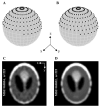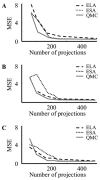Quasi Monte Carlo-based isotropic distribution of gradient directions for improved reconstruction quality of 3D EPR imaging
- PMID: 17095271
- PMCID: PMC1892230
- DOI: 10.1016/j.jmr.2006.10.008
Quasi Monte Carlo-based isotropic distribution of gradient directions for improved reconstruction quality of 3D EPR imaging
Abstract
In continuous wave (CW) electron paramagnetic resonance imaging (EPRI), high quality of reconstructed image along with fast and reliable data acquisition is highly desirable for many biological applications. An accurate representation of uniform distribution of projection data is necessary to ensure high reconstruction quality. The current techniques for data acquisition suffer from nonuniformities or local anisotropies in the distribution of projection data and present a poor approximation of a true uniform and isotropic distribution. In this work, we have implemented a technique based on Quasi-Monte Carlo method to acquire projections with more uniform and isotropic distribution of data over a 3D acquisition space. The proposed technique exhibits improvements in the reconstruction quality in terms of both mean-square-error and visual judgment. The effectiveness of the suggested technique is demonstrated using computer simulations and 3D EPRI experiments. The technique is robust and exhibits consistent performance for different object configurations and orientations.
Figures






References
-
- Fujii H, Berliner LJ. One- and two-dimensional EPR imaging studies on phantoms and plant specimens. Magn Reson Med. 1985;2:275–82. - PubMed
-
- Ferrari M, Quaresima V, Sotgiu A. Present status of electron paramagnetic resonance (EPR) spectroscopy/imaging for free radical detection. Pflugers Arch. 1996;431:R267–8. - PubMed
-
- Fuchs J, Freisleben HJ, Groth N, Herrling T, Zimmer G, Milbradt R, Packer L. One- and two-dimensional electron paramagnetic resonance imaging in skin. Free Radic Res Commun. 1991;15:245–53. - PubMed
-
- Hochi A, Furusawa M, Ikeya M. Applications of microwave scanning ESR microscope: human tooth with metal. Appl Radiat Isot. 1993;44:401–5. - PubMed
-
- Kuppusamy P. EPR spectroscopy in biology and medicine. Antioxid Redox Signal. 2004;6:583–5. - PubMed
Publication types
MeSH terms
Grants and funding
LinkOut - more resources
Full Text Sources
Other Literature Sources
Medical

